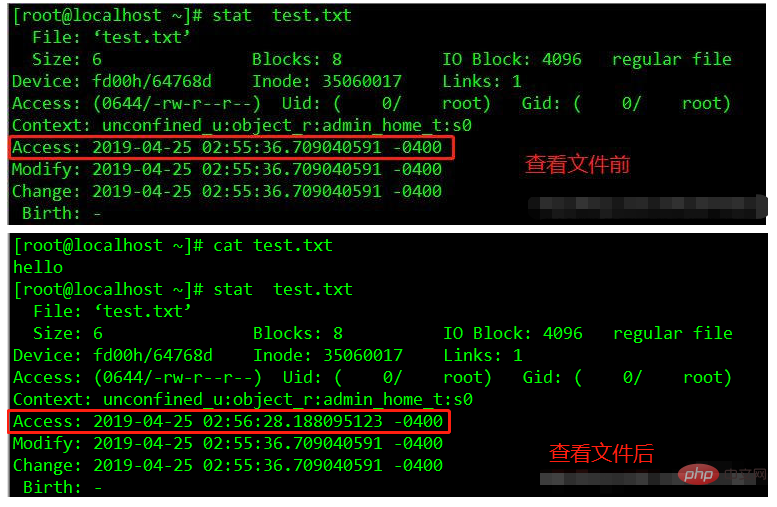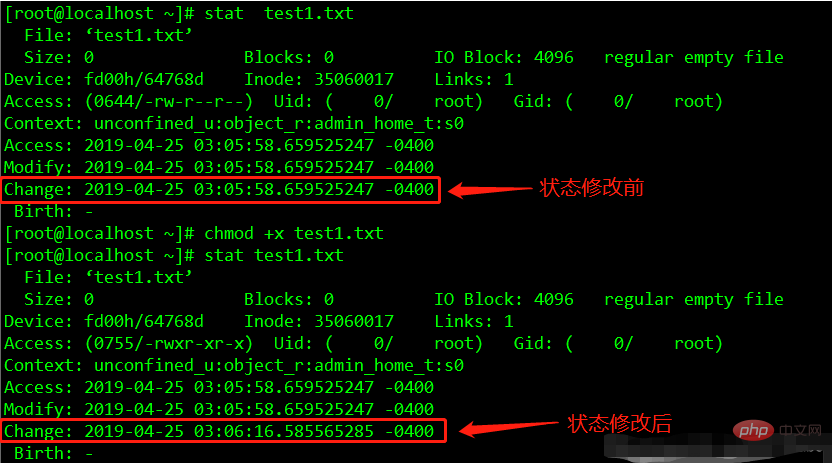How to check file time in linux
How to check the file time in Linux: 1. Use the stat command to check the file time, which can display the status information of the file. The syntax is "stat filename"; 2. Use the ls command to check the file time, "ls -lc filename" The status time of the file can be listed, "ls -lu filename" can list the access time of the file, and "ls -l filename" can list the modification time of the file.

#The operating environment of this tutorial: linux7.3 system, Dell G3 computer.
In Linux, file time is an important attribute of the file. There are three main file times in Linux, namely modification time, access time and status time.
| File Time Attribute | Description | Description |
|---|---|---|
| Modification time | The time when the file content was last modified. The file time displayed by the | ls -l command we often use is this time. When comparing the file content After modification, its mtime will change accordingly. |
| Access time | When a read operation is performed on a file, its access time will change. For example, | cat, more and other operations, but the stat and ls commands will not affect atime. |
| State time | When the status of the file is changed, the status time will change accordingly. For example, when using | chmod, chown, etc. to change file attributes, the ctime of the file will be changed. |
Use the stat command to view the file time
stat filename
- File: Display the file name
- Size: Display the file Size
- Blocks: Total number of data blocks used by the file
- IO Block: IO block size
- regular file: File type (regular file)
- Device: Device number
- Inode: Inode number
- Links: Number of links
- Access: File permissions
- Gid, Uid: Gid and Uid of file ownership
- Access time: Indicates the time when we last accessed (only accessed, no changes) the file
- modify time: Indicates the last time we modified the file Time
- change time: Indicates the time when we last changed the file attributes, including permissions, size, attributes, etc.
- Birth time: File creation time, crtime, but according to the investigation, this attribute has been abandoned in Linux. The current status display results are -
View three file times
Use the stat command to view the time attribute of the test.txt filestat test.txt

Use the ls<span style="font-size: 18px;"></span> command to view the file time
| Description | |
|---|---|
| List the ctime (status time) of the file | |
| List the atime (access time) of the file | |
| List the mtime (modification time) of the file |
The above is the detailed content of How to check file time in linux. For more information, please follow other related articles on the PHP Chinese website!

Hot AI Tools

Undresser.AI Undress
AI-powered app for creating realistic nude photos

AI Clothes Remover
Online AI tool for removing clothes from photos.

Undress AI Tool
Undress images for free

Clothoff.io
AI clothes remover

Video Face Swap
Swap faces in any video effortlessly with our completely free AI face swap tool!

Hot Article

Hot Tools

Notepad++7.3.1
Easy-to-use and free code editor

SublimeText3 Chinese version
Chinese version, very easy to use

Zend Studio 13.0.1
Powerful PHP integrated development environment

Dreamweaver CS6
Visual web development tools

SublimeText3 Mac version
God-level code editing software (SublimeText3)

Hot Topics
 1671
1671
 14
14
 1428
1428
 52
52
 1331
1331
 25
25
 1276
1276
 29
29
 1256
1256
 24
24
 Linux Architecture: Unveiling the 5 Basic Components
Apr 20, 2025 am 12:04 AM
Linux Architecture: Unveiling the 5 Basic Components
Apr 20, 2025 am 12:04 AM
The five basic components of the Linux system are: 1. Kernel, 2. System library, 3. System utilities, 4. Graphical user interface, 5. Applications. The kernel manages hardware resources, the system library provides precompiled functions, system utilities are used for system management, the GUI provides visual interaction, and applications use these components to implement functions.
 vscode Previous Next Shortcut Key
Apr 15, 2025 pm 10:51 PM
vscode Previous Next Shortcut Key
Apr 15, 2025 pm 10:51 PM
VS Code One-step/Next step shortcut key usage: One-step (backward): Windows/Linux: Ctrl ←; macOS: Cmd ←Next step (forward): Windows/Linux: Ctrl →; macOS: Cmd →
 How to check the warehouse address of git
Apr 17, 2025 pm 01:54 PM
How to check the warehouse address of git
Apr 17, 2025 pm 01:54 PM
To view the Git repository address, perform the following steps: 1. Open the command line and navigate to the repository directory; 2. Run the "git remote -v" command; 3. View the repository name in the output and its corresponding address.
 How to run java code in notepad
Apr 16, 2025 pm 07:39 PM
How to run java code in notepad
Apr 16, 2025 pm 07:39 PM
Although Notepad cannot run Java code directly, it can be achieved by using other tools: using the command line compiler (javac) to generate a bytecode file (filename.class). Use the Java interpreter (java) to interpret bytecode, execute the code, and output the result.
 How to run sublime after writing the code
Apr 16, 2025 am 08:51 AM
How to run sublime after writing the code
Apr 16, 2025 am 08:51 AM
There are six ways to run code in Sublime: through hotkeys, menus, build systems, command lines, set default build systems, and custom build commands, and run individual files/projects by right-clicking on projects/files. The build system availability depends on the installation of Sublime Text.
 What is the main purpose of Linux?
Apr 16, 2025 am 12:19 AM
What is the main purpose of Linux?
Apr 16, 2025 am 12:19 AM
The main uses of Linux include: 1. Server operating system, 2. Embedded system, 3. Desktop operating system, 4. Development and testing environment. Linux excels in these areas, providing stability, security and efficient development tools.
 laravel installation code
Apr 18, 2025 pm 12:30 PM
laravel installation code
Apr 18, 2025 pm 12:30 PM
To install Laravel, follow these steps in sequence: Install Composer (for macOS/Linux and Windows) Install Laravel Installer Create a new project Start Service Access Application (URL: http://127.0.0.1:8000) Set up the database connection (if required)
 git software installation
Apr 17, 2025 am 11:57 AM
git software installation
Apr 17, 2025 am 11:57 AM
Installing Git software includes the following steps: Download the installation package and run the installation package to verify the installation configuration Git installation Git Bash (Windows only)







